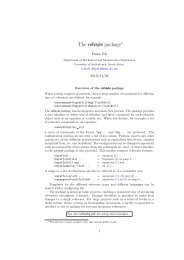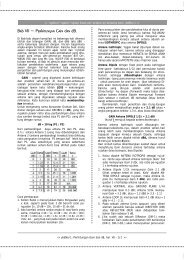Create successful ePaper yourself
Turn your PDF publications into a flip-book with our unique Google optimized e-Paper software.
techniques. The most extensively used technique is a combination<br />
of anode and screen modulation. Often additional modulation must<br />
be provided on the control grid to reach 100 per cent modulation on<br />
the positive peaks. Figure 40 shows three of the basic anode and<br />
screen modulation circuits.<br />
In anode and screen modulation it is necessary to introduce not<br />
only amplitude modulation of the anode voltage, but also to develop<br />
70 to 100 per cent amplitude modulation of the screen voltage for<br />
100 per cent carrier modulation. Modulation of the screen voltage<br />
can be developed in one of the folowing three ways:<br />
66<br />
(a) By supplying the screen voltage through a dropping resistor<br />
connected to the unmodulated d-c anode supply.<br />
(b) When a low voltage fixed screen supply is used, a modulation<br />
choke is placed in series with the supply. In the case of voice<br />
modulation, this is about a 5 to 10 henry choke.<br />
(c) A third winding on the modulation transformer designed to<br />
develop the required screen modulation voltage.<br />
It is interesting to note that in all three cases the screen of the<br />
tetrode or pentode tube supplies the necessary audio power.<br />
During the portion of the modulation cycle, when the anode voltage<br />
is increased, the screen current decreases. If the screen is supplied<br />
through an impedance, such as the screen dropping resistor of<br />
a modulation choke, the voltage drop in this series impedance<br />
becomes less and the screen voltage rises in the desired manner.<br />
On the part of the modulation cycle when the anode voltage is<br />
decreased, the screen current increases causing a greater voltage<br />
drop in the screen series impedance and thus lowering the voltage<br />
on the screen of the tube. The screen by-pass capacitor value in<br />
the Class stage is a compromise between good r-f bypassing and<br />
the shunting effect of this capacitance on the screen modulation<br />
circuit.<br />
Where 100 per cent modulation capabilities are desired, the tube<br />
efficiency under carrier conditions is about half that expected<br />
in the r-f amplifier when anode and screen modulation is used.<br />
This efficiency is usually on the order of 35 to 40 per cent. Grid<br />
and screen modulation is used when there is a desire to save on<br />
physical size and cost of the modulation source.<br />
When grid modulation is used, the screen voltage and grid bias<br />
must be taken from sources with good regulation. This usually<br />
means a separate low voltage power supply source. In the case of
















